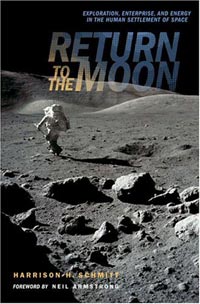Review: Return to the Moonby Anthony Young
|
| The subtitle conveys the essence of the economic benefits of returning to the Moon and exploiting the possibilities they holds for both the energy needs of a permanent base on the Moon, and of the Earth. |
He remained with NASA until 1975 in the capacity of Chief of Scientist-Astronauts and then NASA Assistant Administrator for Energy Programs. He resigned from NASA and, with political aspirations, ran for US Senator for his home state of New Mexico and won in 1976. His six-year stint was instrumental in better understanding the political machinations of Washington, which also features in his book in terms of the role of government support of space exploration. Schmitt chose to return to the private sector after his term in office. Lunar exploration by the US was all but abandoned, but Schmitt continued to speak out on the need for renewed lunar exploration and its commercial aspects. In 1994 he was appointed Adjunct Professor of Engineering at the University of Wisconsin, and it was here he contributed to the research into the possibility of helium-3 fusion for generating energy.
Helium-3 and the future of energy
Schmitt does not see our return to the Moon as economically viable without private enterprise becoming integrally involved, and justified only if America and its partners return to the Moon to stay. That means a permanent base, and eventually several bases. Schmitt’s book acknowledges the need to exploit the Moon’s resources in situ. The chief motivation in returning to the Moon, writes Schmitt, is the potential for energy generation that is locked within the lunar soil. Helium-3, arriving at the Moon by the solar wind, is imbedded deep in the lunar soil as a trace, non-radioactive isotope. Schmitt says the energy in the raw lunar soil could be unleashed through the process of deuterium/helium-3 fusion. Small-scale fusion experiments have been taking place at the University of Wisconsin-Madison Fusion Technology Institute, where Schmitt is a professor. He discusses other means of fusion processes in context. What Schmitt envisions for the future are spacecraft returning small quantities of helium-3 from mined and processed lunar soil to Earth. There, deuterium/helium-3 fusion would be used to generate energy. He goes into considerable detail explaining the economics of making this viable.
Schmitt draws on the successful Apollo program as a model of how future lunar programs should be run and as an engineering baseline of what future launch vehicles should be. However, Apollo was achieved as a geopolitical imperative and with generous government resources. Future missions returning to the Moon will not have that luxury. Schmitt writes: “The cost of placing large payloads on the Moon will constitute the single greatest component of the total cost of obtaining lunar Helium-3 fuel.” He cites the Saturn 5’s capability as a benchmark: the ability to launch 48,000 kilograms to trans-lunar injection (the familiar, “You are go for TLI”). He states the next-generation heavy-lift booster, which he dubs the Saturn 6, should have the capability of putting 100,000 kilograms on the way to the Moon. Schmitt also discusses shuttle-derived vehicles. This portion of the book was written months before NASA Administrator Michael Griffin announced the results of the Exploration Systems Architecture Study. Although many engineering details for the shuttle-derived heavy-lift launcher have yet to be worked out, its payload capability makes it a viable candidate for getting necessary 50,000 to 100,000 kilograms of mining and processing equipment to the Moon, and lunar soil payload returned to Earth.
| Schmitt draws on the successful Apollo program as a model of how future lunar programs should be run and as an engineering baseline of what future launch vehicles should be. |
Schmitt examines the various forms, or fuels, used in fusion, including helium-3, and the economics of power generation from these different fusion methods. There is a chapter on the resources of helium-3 on the Moon. Chapter 7 goes into considerable detail on lunar settlement for the purpose of mining, processing and refining helium-3, and the means of power generation on the lunar surface until electrical power could be obtained from helium-3 fusion; this chapter includes discussions about employee selection and compensation, risk management, and necessary consumables that will have to come from Earth. There is a chapter dealing with return on investment (ROI) and management issues. Related to this is the chapter covering the lessons learned from Apollo that could be applied to future lunar efforts. Schmitt pulls no punches in his chapter covering the restructuring of NASA for deep space efforts and the need to bring young engineers and managers into prominent positions of decision-making.
To achieve the commercial aspects of these efforts, Chapter 11, “Investors: The Best Approach”, is a business plan for attracting investors through the economic rewards of not just the sale of helium-3 but also the countless spinoff technologies and services as a result of lunar settlement. There is even a chapter devoted to past and present laws, both terrestrial and celestial, and a section covering property and mineral rights. The last chapter of the book deals with humans in space exploration: how men and women must be protected from prolonged radiation, the problem of lunar dust and its mitigation, physiological deterioration from one-sixth gravity and weightlessness, medical emergency issues, and even family development.
There have been many books written about future lunar exploration and the long-term benefits to the Moon’s and Earth’s occupants of doing so. Only one book, however, has been written by a man who has actually been to the Moon, explored its surface, and knows firsthand the economic benefits locked in the Moon’s regolith. Harrison Schmitt’s Return to the Moon will serve as a blueprint for how to achieve this and contribute to making the Vision for Space Exploration a reality.
